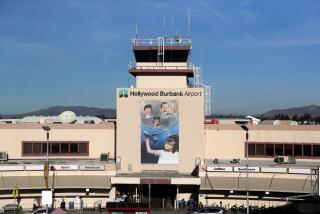Bob Hope Airport officials go back to drawing board on transit center
- Share via
Bob Hope Airport officials Monday said they would have to scale down a planned transit center after construction bids came in about 40% to 60% higher than the projected $112-million price tag.
Airport officials blamed high steel costs and a “fear factor” among contractors — concerns that the project could not be built as planned — as the main reasons bids came in between $47 million and $69 million above what had been anticipated.
“This wasn’t the outcome we were looking for,” Executive Director Dan Feger told members of the Burbank-Glendale-Pasadena Airport Authority on Monday.
To reduce costs, Feger proposed eliminating the top floor of what was to be a four-story facility, redesigning a steel-truss ceiling and making other changes to the center, which is intended to centralize rental car, taxi, bus and train connections under one roof.
The high bids caught airport officials off guard.
“I’m not 100% convinced we should move forward with this in this economy,” said Don Brown, a commissioner representing Burbank.
But Feger said a project revamp would allow the airport to get the job done on budget. “This go-forward strategy will reduce costs dramatically,” he said.
The commission took no action Monday. Staff members are now working on a revised budget and design.
Feger said the changes would add four to six months to the project, estimating the time needed for a redesign, seeking new approvals from the city and sending the project back out to bid. Originally, the plan was to start work this year, with completion in about 12 months.
Feger cited several reasons for the unexpectedly high bids. As designed, the center would require 15,000 tons of high-strength steel that meets the most stringent earthquake safety standards. The special steel costs about $3,800 a ton, up to $1,200 more than steel used in most construction, he said. And because the project includes a “buy American” provision, contractors were constrained in trying to get a competitive steel price, Feger said.
Contractors also mentioned a “fear factor” that the project could not be built as designed or on the envisioned 12-month schedule and that they would face increased liability if something went wrong, Feger said.
The intermodal transit center would replace the airport’s rental car facilities, which are too close to a runway, according to the Federal Aviation Administration. Rental cars must also be taken off premises to be washed and refueled, resulting in about 700,000 trips on city streets each year.
More to Read
Sign up for Essential California
The most important California stories and recommendations in your inbox every morning.
You may occasionally receive promotional content from the Los Angeles Times.













